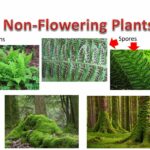Introduction
There is a huge variety of plant life in the botanical world, from the bright colors of blooming plants to the subtle beauty of non-flowering plants. Angiosperms, or blooming plants, get most of the attention, but non-flowering plants like ferns, mosses, liverworts, and gymnosperms are just as important to the ecosystem. This article takes a look at the interesting world of non-flowering plants, including their unique traits, how they have changed over time, how they affect the environment, and what they add to the natural world.
A Brief Look at Plants That Don’t Bloom
Cryptogams are another name for non-flowering plants. They are a varied group of plant species that reproduce without making flowers. They don’t have the parts that are usually found on blooming plants, like fruits and seeds that are protected by an ovary. This area includes a number of big groups:
Ferns and Fern Allies: Ferns have unique leaves called fronds and structures called sporangia that make spores. Fern friends, like horsetails and clubmosses, have some of the same characteristics as ferns, but they also have their own traits.
Mosses are small, spore-producing plants that don’t have stems or roots. They are very important for making land and places to live.
Liverworts are simple, green plants that usually grow best in damp places. They help keep the earth stable and move nutrients around.
Gymnosperms: Gymnosperms are seed-bearing plants that have seeds that are not covered. These seeds are often found in cones. Conifers, cycads, ginkgoes, and gnetophytes are all in this group.
How plants that don’t bloom have changed over time
Non-flowering plants have adapted in a variety of ways that make them able to live in different places:
Spore Reproduction: Unlike flowering plants, which reproduce through seeds, non-flowering plants rely on spores for reproduction. Spores are lightweight and easily dispersed by wind, water, or other means.
Water-Dependent Life Cycles: Many non-flowering plants have a life cycle that requires water for fertilization, as sperm cells need to swim to reach the egg. Because they need water, they have changed in ways that let them live in wet places.
Reduced Structures: Non-flowering plants often have simpler structures than flowering plants, as they lack the complex reproductive organs and tissues associated with flowers and fruits.
Diverse Reproductive Strategies: Non-flowering plants exhibit a wide array of reproductive strategies, including fragmentation, gemmae production, and asexual reproduction, allowing them to colonize new habitats efficiently.
Ecological Significance and Contributions
Non-flowering plants play crucial roles in various ecosystems and have profound ecological significance.
Soil Formation and Stabilization: Mosses and liverworts contribute to soil formation by accumulating organic matter and providing a substrate for other plants to establish themselves. Their ability to colonize harsh environments makes them vital players in soil stabilization.
Carbon Sequestration: Non-flowering plants, especially peat-forming mosses, play a significant role in carbon sequestration, aiding in the regulation of atmospheric carbon dioxide levels.
Habitat Creation: Non-flowering plants create microhabitats that support a wide range of organisms, from insects to small animals. These habitats provide shelter, food sources, and breeding grounds.
Nutrient Cycling: Non-flowering plants contribute to nutrient cycling by breaking down organic matter and facilitating nutrient transfer within ecosystems.
Indicator Species: Some non-flowering plants are sensitive to environmental changes, making them valuable indicators of ecosystem health and environmental disturbances.
Conservation and Preservation
Despite their ecological importance, non-flowering plants often receive less attention in conservation efforts compared to their flowering counterparts. However, their preservation is vital for maintaining biodiversity, ecosystem stability, and the overall health of natural habitats.
Conclusion
Non-flowering plants may lack the vibrant colors and conspicuous blooms of flowering plants, but their understated elegance and ecological contributions make them essential components of the natural world. From the lush carpets of mosses that blanket forest floors to the majestic conifers that dominate certain landscapes, non-flowering plants leave an indelible mark on ecosystems across the globe. By understanding and appreciating their unique adaptations and roles, we can better comprehend the intricate web of life that sustains our planet.
Introduction
There is a huge variety of plant life in the botanical world, from the bright colors of blooming plants to the subtle beauty of non-flowering plants. Angiosperms, or blooming plants, get most of the attention, but non-flowering plants like ferns, mosses, liverworts, and gymnosperms are just as important to the ecosystem. This article takes a look at the interesting world of non-flowering plants, including their unique traits, how they have changed over time, how they affect the environment, and what they add to the natural world.
A Brief Look at Plants That Don’t Bloom
Cryptogams are another name for non-flowering plants. They are a varied group of plant species that reproduce without making flowers. They don’t have the parts that are usually found on blooming plants, like fruits and seeds that are protected by an ovary. This area includes a number of big groups:
Ferns and Fern Allies: Ferns have unique leaves called fronds and structures called sporangia that make spores. Fern friends, like horsetails and clubmosses, have some of the same characteristics as ferns, but they also have their own traits.
Mosses are small, spore-producing plants that don’t have stems or roots. They are very important for making land and places to live.
Liverworts are simple, green plants that usually grow best in damp places. They help keep the earth stable and move nutrients around.
Gymnosperms: Gymnosperms are seed-bearing plants that have seeds that are not covered. These seeds are often found in cones. Conifers, cycads, ginkgoes, and gnetophytes are all in this group.
How plants that don’t bloom have changed over time
Non-flowering plants have adapted in a variety of ways that make them able to live in different places:
Spore Reproduction: Unlike flowering plants, which reproduce through seeds, non-flowering plants rely on spores for reproduction. Spores are lightweight and easily dispersed by wind, water, or other means.
Water-Dependent Life Cycles: Many non-flowering plants have a life cycle that requires water for fertilization, as sperm cells need to swim to reach the egg. Because they need water, they have changed in ways that let them live in wet places.
Reduced Structures: Non-flowering plants often have simpler structures than flowering plants, as they lack the complex reproductive organs and tissues associated with flowers and fruits.
Diverse Reproductive Strategies: Non-flowering plants exhibit a wide array of reproductive strategies, including fragmentation, gemmae production, and asexual reproduction, allowing them to colonize new habitats efficiently.
Ecological Significance and Contributions
Non-flowering plants play crucial roles in various ecosystems and have profound ecological significance.
Soil Formation and Stabilization: Mosses and liverworts contribute to soil formation by accumulating organic matter and providing a substrate for other plants to establish themselves. Their ability to colonize harsh environments makes them vital players in soil stabilization.
Carbon Sequestration: Non-flowering plants, especially peat-forming mosses, play a significant role in carbon sequestration, aiding in the regulation of atmospheric carbon dioxide levels.
Habitat Creation: Non-flowering plants create microhabitats that support a wide range of organisms, from insects to small animals. These habitats provide shelter, food sources, and breeding grounds.
Nutrient Cycling: Non-flowering plants contribute to nutrient cycling by breaking down organic matter and facilitating nutrient transfer within ecosystems.
Indicator Species: Some non-flowering plants are sensitive to environmental changes, making them valuable indicators of ecosystem health and environmental disturbances.
Conservation and Preservation
Despite their ecological importance, non-flowering plants often receive less attention in conservation efforts compared to their flowering counterparts. However, their preservation is vital for maintaining biodiversity, ecosystem stability, and the overall health of natural habitats.
Conclusion
Non-flowering plants may lack the vibrant colors and conspicuous blooms of flowering plants, but their understated elegance and ecological contributions make them essential components of the natural world. From the lush carpets of mosses that blanket forest floors to the majestic conifers that dominate certain landscapes, non-flowering plants leave an indelible mark on ecosystems across the globe. By understanding and appreciating their unique adaptations and roles, we can better comprehend the intricate web of life that sustains our planet.












